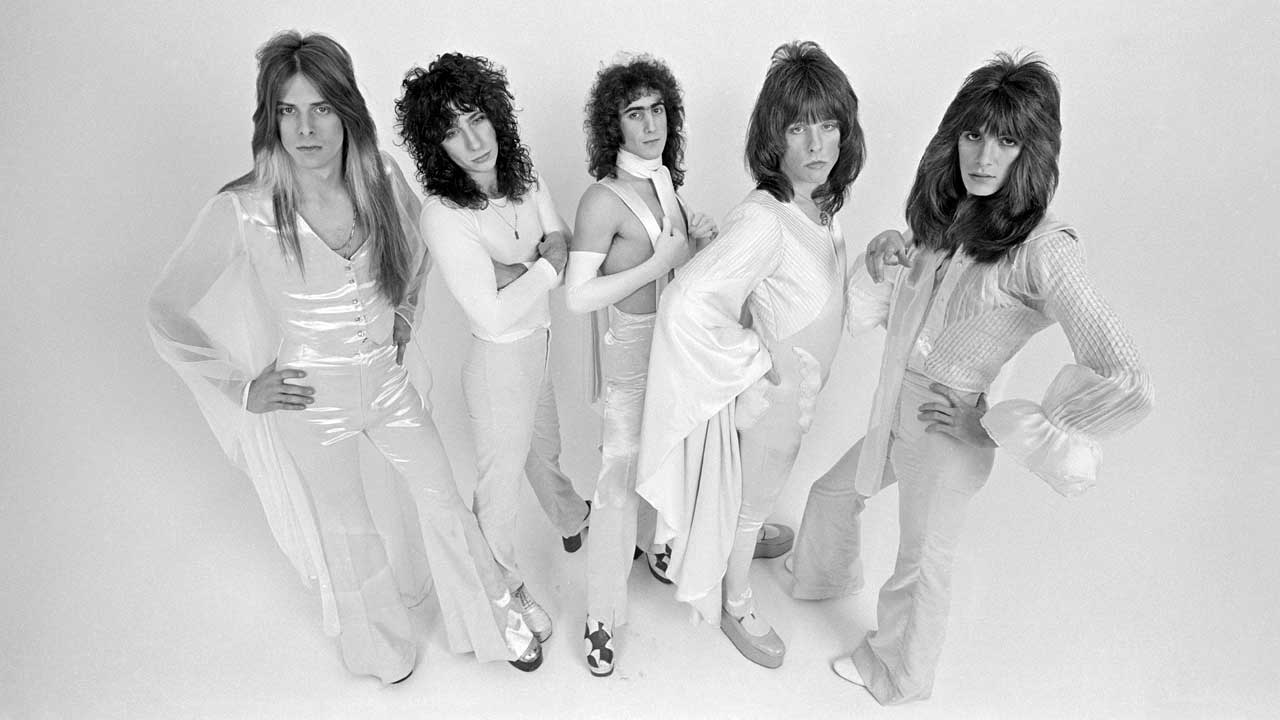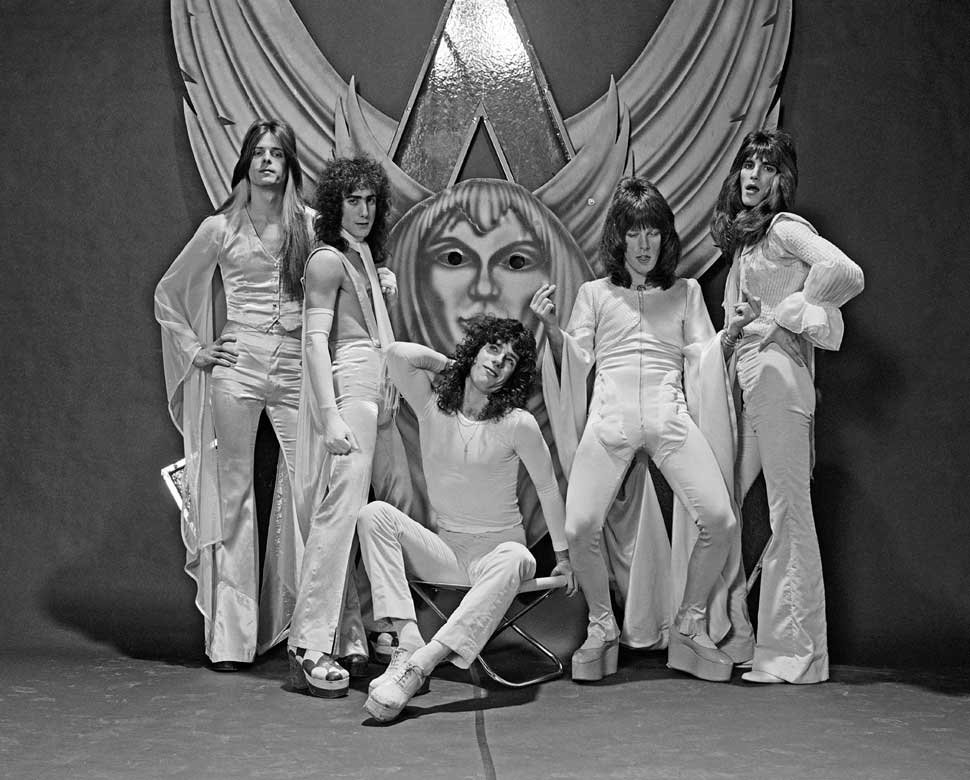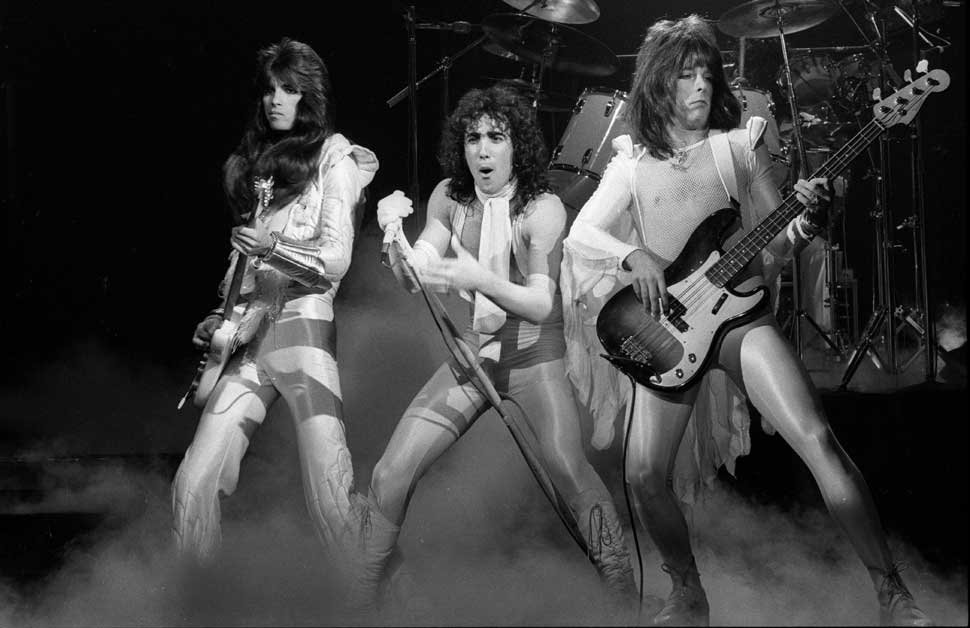
On Earth As It Is In Heaven is the album that most divides opinion among Angel fans. While you could hardly call it their Marmite album, as I’ve yet to encounter an Angel fan who truly loathes the record, it is – bar their 1999 comeback album In The Beginning – the Angel release that has disappointed fans the most. Its mixture of songs remains confusing, while its production promised so much, but didn’t quite deliver. Still, the album has enjoyed a great deal more respect in the years since its release, as fans have learned more about its gestation and grown to understand this most curious record.
Angel’s third album, released in March 1977, On Earth… contained the kind of pomp rock epics that the band had excelled at on their earlier releases – including Cast The First Stone (a holdover from the group’s second record, Helluva Band) and the haunting Just A Dream – as well as straight-ahead hard-rock fare such as Can You Feel It. It was also, however, a rather ambitious record.
We now know that the group who wrote and recorded it were in a state of flux, awkwardly moving from their progressive hard-rock roots towards what they – and, perhaps more pertinently, the record company – hoped would be a more chart-friendly sound that leaned heavily on their undoubted Beatles influences. The poppier Telephone Exchange, ridiculously titled Big Boy (Let’s Do It Again) and quirky That Magic Touch seemed a little out of place.
White Lightning, meanwhile, was a reappraisal of a song that Angel guitarist Punky Meadows and bassist Mickie Jones had first recorded with former band Bux. Co-written with that band’s vocalist Ralph Mormon (who sadly passed away in August 2014), the Angel version retained some of the funkier elements of the original, but was now topped with a sprinkling of Gregg Giuffria’s piano skills and had been finely rehearsed as part of Angel’s live set throughout 1976.

Having issued their self-titled debut album in October 1975 and followed it up with Helluva Band a mere seven months later in May 1976, Angel had suddenly come to something of a premature crossroads in their career.
Despite making their presence known on the live circuit, where they established loyal pockets of support for themselves in places like Cleveland, Chicago and St. Louis, the quintet (completed by vocalist Frank DiMino and drummer Barry Brandt) had failed to make serious headway into the Billboard charts, either through album sales or via the singles market. This was despite the group being voted the best new band of 1976 in the influential Circus magazine’s readers’ poll, ahead of Heart and Boston.
When it came time to begin work on the third album, Casablanca Records felt that fresh input was required and that the production team of Derek Lawrence and Big Jim Sullivan – who had helmed the first two records – should be replaced by someone with a more impressive reputation. And it would appear that there was no one bigger in the eyes of Casablanca executives at that time than former Hendrix producer Eddie Kramer, who had helped propel Kiss into the international spotlight through his work on Alive! and the recent Rock And Roll Over album.
Kramer wasn’t Angel’s first choice. “We had talks with Roy Thomas Baker of Queen fame,” Frank DiMino once told me. "But Eddie was an intriguing guy, and we got along really well with him.”
Well, to a point. Gregg Giuffria once admitted he “locked [Kramer] out of the studio when I recorded my keyboard intros!”
Although the album was originally set to be recorded at the Record Plant in LA, the group reconvened in the Emerald Castle, located above The Source restaurant on Sunset Boulevard in Hollywood, using a mobile facility to record in the empty rooms. The band also used some quite expensive – not to mention innovative for the time – technology by installing video monitor hookups in the rooms to view each other laying down the various tracks.
While the majority of the album was recorded at the Castle, some of DiMino’s vocals were later cut at the Record Plant and at Electric Lady Studios in New York City.
“Eddie and I were in New York when [band manager] David Joseph called to say that the album was going to be released in Japan earlier than everywhere else, as we had an impending tour there,” recalls Frank. “It wasn’t really ready, but we agreed that we’d mix it quickly and then go back and spend more time on it. At least two tracks, including Can You Feel It, have early mixes on the Japanese record. The different running order on the Japanese version was down to putting something together quickly. We put more thought into it once the album was ready for release for all other markets.”

It’s this Japanese mix that Rock Candy tastefully reissued in 2012 and, I have to say, the running order is, to these ears, rather more cohesive than the more common version.
Angel toured Japan in February 1977. It would be the only time the original band would play outside of North America and, according to the band’s tour manager, Bill Schereck, the visit was against expert advice as the main promoter in Japan had felt it was a little too early for the band to have toured there.
“It was a great adventure, but a bit of a debacle,” Bill told me. “David Joseph wanted to push things faster. Another promoter offered us a lot of money to do it, so we went.”
One of the main issues concerning the crew was that the Japanese tour would introduce the band’s new stage set. There was an awful lot of it, adding to the logistical headaches of touring abroad for the first time. Developed with the aid of illusionist Johnny Gaughan and featuring talking logos and miraculous onstage appearances and exits – not to mention an over-the-top introduction voiced by Marvin Miller of 50s US TV show The Millionaire, set to the theme tune from Ben Hur – Angel’s stage show has long since become the stuff of legend.
It was actually touch and go whether the equipment would make it back in time for the commencement of Angel’s next US tour. The last Japanese show was in Nagoya on February 17th, and the first date in the States was at the Santa Monica Civic a mere two days later, but there was a problem flying the equipment back to the States – the promoter had paid for the freight costs with a rubber cheque that bounced before the gear left Japan, meaning there was a real danger that the band, who had already flown ahead on an earlier flight, would get to the venue and have nothing to work with. Thankfully, the problem was resolved with seconds to spare.
Still, from the band’s perspective the Japanese trip was a success. “It was absolutely crazy,” recalls Frank DiMino. “We couldn’t work out why it was happening for us in Japan but not in the States. We played eight shows and they were amazing. The kids followed us everywhere.”
Of course, when discussing, some mention must be made of the packaging, as On Earth… introduced Angel’s infamous ambigram logo, based upon an original design by Bob Petrick.
“I started randomly doing invertible lettering pieces in 1975,” Petrick himself told me a few years ago. “The word ‘Angel’ was one of the first pieces I designed. Although I wasn’t very familiar with Angel’s music, I had liked the graphics on their records, but sensed they were looking for something to set them apart, since they were already an extremely eccentric and flamboyant act. I had heard the band was performing at the Spectrum in Philadelphia – this was back in 1976 – and decided to be bold and go directly to the management.
"I showed my artwork in a rough stage and to my shock everyone liked it and immediately saw its potential. That was all I needed, to be inspired to do the best piece I had ever done. Thanks to the Angel logo, I later got a gig at the Art Hotel design studio in LA. I wish that went better than it did, but it was quite an experience, and I did do logos for Lipps Inc and a few others, including a piece for Donna Summer.”
Even with great packaging and unique logos, the chart breakthrough that both Angel and Casablanca craved would still elude the group. Despite heavy touring throughout the US until mid May ’77, On Earth As It Is In Heaven would only peak on the Billboard charts at No.76, with That Magic Touch reaching No.77 in the singles chart. Frustrated, the band went back to the drawing board. Changes were afoot, the most significant of these being the decision to fire bassist Mickie Jones. “We had gone as far as we could with Mickie,” states DiMino.
Jones’ replacement was St Louis-born Felix Robinson, at the time playing in a jazz rock troupe called The Word, who just so happened to be managed by Bill Schereck. Felix had previously played in a band called Griffin with Danny Prosser (later of the Jack Street Band) and had made his recording debut back in 1974 on an album released through A&M by trumpet player Phil Driscoll. Robinson’s recruitment would lead to a new phase in Angel’s trajectory and, at that point in time, the future looked White Hot…







